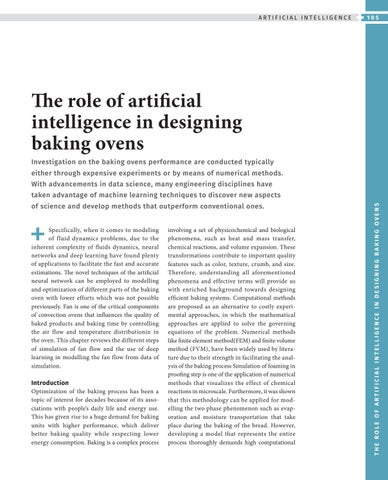ARTIFICIAL INTELLIGENCE
105
The role of artificial intelligence in designing baking ovens Investigation on the baking ovens performance are conducted typically either through expensive experiments or by means of numerical methods. taken advantage of machine learning techniques to discover new aspects of science and develop methods that outperform conventional ones.
+
Specifically, when it comes to modeling of fluid dynamics problems, due to the inherent complexity of fluids dynamics, neural networks and deep learning have found plenty of applications to facilitate the fast and accurate estimations. The novel techniques of the artificial neural network can be employed to modelling and optimization of different parts of the baking oven with lower efforts which was not possible previousely. Fan is one of the critical components of convection ovens that influences the quality of baked products and baking time by controlling the air flow and temperature distributionin in the oven. This chapter reviews the different steps of simulation of fan flow and the use of deep learning in modelling the fan flow from data of simulation. Introduction Optimization of the baking process has been a topic of interest for decades because of its associations with people’s daily life and energy use. This has given rise to a huge demand for baking units with higher performance, which deliver better baking quality while respecting lower energy consumption. Baking is a complex process
involving a set of physicochemical and biological phenomena, such as heat and mass transfer, chemical reactions, and volume expansion. These transformations contribute to important quality features such as color, texture, crumb, and size. Therefore, understanding all aforementioned phenomena and effective terms will provide us with enriched background towards designing efficient baking systems. Computational methods are proposed as an alternative to costly experimental approaches, in which the mathematical approaches are applied to solve the governing equations of the problem. Numerical methods like finite element method(FEM) and finite volume method (FVM), have been widely used by literature due to their strength in facilitating the analysis of the baking process Simulation of foaming in proofing step is one of the application of numerical methods that visualizes the effect of chemical reactions in microscale. Furthermore, it was shown that this methodology can be applied for modelling the two phase phenomenon such as evaporation and moisture transportation that take place during the baking of the bread. However, developing a model that represents the entire process thoroughly demands high computational
IM T H AE GREOPL RE OOCFE SA SR ITNI G FIC A IPAPLL I C N AT TE ILOL NI GS E FNOCRE BI NA KDI ENSGI GPNRIONCGE S B SA KMI O NN G IO TO V ER N I NS G
With advancements in data science, many engineering disciplines have




























